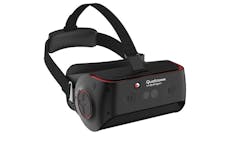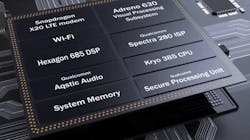Qualcomm's new virtual-reality (VR) reference design (Fig. 1) and matching VR development kit with SDK takes advantage of its Snapdragon 845 system-on-chip (SoC). The Snapdragon 845 is the basis of many of the latest smartphones, including Samsung’s new Galaxy S9. The platform targets VR and augmented-reality (AR) applications.
1. Qualcomm’s VR reference design leverages the company’s Snapdragon 845 SoC.
The reference design and dev kit software support foveated rendering. This utilizes eye tracking feedback to identify where a person is looking, and in turn enables the rendering software to concentrate rendering resources on that area while reducing processing in other areas. This is crucial because rendering is compute-intensive and pushes the performance envelope even with this SoC. The reduced image quality isn’t noticeable since it’s viewed via peripheral vision, allowing the system to provide more detailed rendering in areas that the user is concentrating on.
The Snapdragon 845 Virtual Reality Development Kit includes major components such as room-scale six-degree-of-freedom (6DoF) simultaneous localization and mapping (SLAM) support, Qualcomm Adreno Foveation, eye-tracking support, and boundary system support. The room-scale 6DoF SLAM support is designed to deliver untethered VR support using “inside-out” SLAM. This is done using sensor integration, including motion sensors such as 3D gyros and accelerometers as well as eye tracking and camera inputs.
The eye-tracking support was developed in conjunction with Tobii. Tobii’s EyeCore eye-tracking algorithms are incorporated into the development kit’s software. It allows content to be rendered utilizing gaze direction information for fast interaction, as well as enable software to deliver more intuitive user interfaces.
The boundary support is used to identify real-world constraints so that the application can provide feedback to the user. This may be in the form of notifications or changes in gameplay or presentations.
A Peek Inside the Snapdragon
The Snapdragon 845 (Fig. 2) is built around the Kyro 385 CPU, which has eight cores including four, 2.8-GHz high performance “Gold” cores based on the 64-bit ARM Cortex-A75 plus four, 1.8-GHz high-efficiency “Silver” cores based on the ARM Cortex-A55. These can operate in a big.LITTLE configuration, balancing performance and power utilization.
2. The Snapdragon 845 integrates the 8-core Kyro 385 CPU, along with a host of accelerators including a DSP with advanced AI support.
The SoC also features an array of built-in accelerators, subsystems, and peripherals, including the Snapdragon X20 LTE modem. For instance, the Adreno 630 Visual Processing Subsystem is designed to drive displays up to 2400 by 2400 pixels per eye, although the reference design has a resolution of 1024 by 1152 pixels. This subsystem handles graphics, video and display processing support of 4K videos, as well as H.264 (AVC), H.265 (HEVC), VP9, and DisplayPort over USB Type-C support. It handles room-scale 6DoF SLAM.
Then there’s the Hexagon 685 DSP, which includes the Hexagon Vector DSP (HVX), the Hexagon Scalar DSP for audio processing, the Hexagon All-Ways Aware Hub for sensor fusion, and Qualcomm’s Snapdragon Neural Processing Engine. The latter provides support of machine-learning (ML) applications. The system also includes the Qualcomm Aqstic and aptX audio support.
The Spectra 280 Image Signal Processor has a 14-bit image signal-processing architecture that can support for up to a single 32-Mpixel camera at 30 frames/s, dual 16-Mpixel cameras at 30 frames/s, and a single HFR 16-Mpixel camera at 60 frame/s. It maintains up to seven camera inputs.
The SoC also has a Secure Processing Unit (SPU), 802.11ad multi-gigiabit Wi-Fi with MIMO support, and Bluetooth 5 and GPS support.
Furthermore, Qualcomm announced support for the HTC Vive Wave VR SDK that will work with Snapdragon 845 Virtual Reality Development Kit. It will be available later this year. The Vive Wave VR SDK will offer a path to monetizing applications on future HTC Vive-ready products via the multi-OEM Viveport application store.




